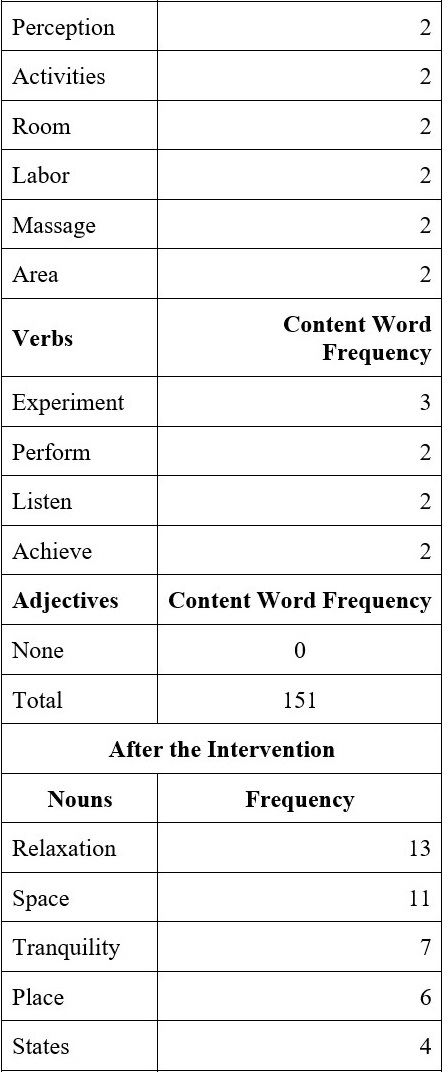Introduction
The significance of COVID-19 as a widespread problem is undeniable. As of October 2021, there were approximately 250,000,000 confirmed cases and 5,000,000 deaths globally, making COVID-19 a major contributor to the global burden of acute and chronic disease (1). In Colombia, the pandemic posed an unprecedented challenge due to its ranking among countries with the highest number of cases and deaths in Latin America, alongside Brazil and Mexico. This situation, coupled with Colombia's complex social, economic, and public order issues, exacerbated the pandemic's impact, resulting in hospital collapses during the second and third waves of the pandemic (2). Additionally, the serious public order situation in the country, which led to a large portion of the population in the streets and blockades on public roads, increased the virus's speed of transmission, caused shortages of medicines and hospital supplies, and created geographical barriers for patients to access care centers (3–5).
Colombian healthcare workers faced the same challenges that the pandemic brought to their counterparts worldwide, but with several aggravating factors. These included a lack of knowledge about caring for people with COVID-19, a scarcity of scientific evidence in languages other than Spanish, a shortage of personal protective equipment (6), an insufficient number of personnel to handle the high volume of patients, stigmatization by the general population (7), low wages, and a lack of labor guarantees (8).
Numerous studies from different parts of the world have reported high prevalence of mental health issues among health care workers during the COVID-19 pandemic. For instance, stress was found in 35% of health personnel (9), while moderate to severe anxiety affected 60-73% and severe depression affected 40-94% (10,11). These psychological distress can also lead to post-traumatic stress disorder (12). In Colombia, a study conducted with physicians showed that one third of them had moderate levels of work-related stress, and 6% had severe stress. Furthermore, 72.9% of the participants reported symptoms of anxiety, and 37.1% reported fear of COVID-19, with higher rates observed in those working in capital cities (13). Another study reported a prevalence of 38.4% for generalized anxiety disorder (GAD) and 50% for fear of COVID-19 among Colombian health workers. The study also identified several predictors of GAD, including stress, nervousness, fear, fatigue, viral symptoms, job dissatisfaction, and perceived discrimination as health personnel during the pandemic (14).
In light of the challenging circumstances faced by health workers during the COVID-19 pandemic, timely interventions were necessary to alleviate their psychological distress. These interventions had to be fast, feasible, and easily accessible in real time, given the limited time available in healthcare settings where psychological symptoms were prevalent (15). To this end, the Social Support and Research teams of the Hospital Militar Central in Bogotá, Colombia, leveraged all available resources to address the psychological symptoms of health workers (16), and decided to expose a group of emergency service professionals to a multisensory room designed for children with mixed disorders. Multisensory rooms, such as the Snoezelen rooms, have been extensively researched and provide multisensory experiences of stimulation or relaxation through visual, olfactory, tactile, sound, and taste stimuli. Previous studies have demonstrated that multisensory stimulation in Snoezelen rooms can improve memory and balance in people with learning disabilities (17), decrease symptoms of autism (18) reduce fear and postpartum anxiety (19), alleviate agitation in patients with dementia in long-term care institutions (20), and decrease work-related stress in nursing professionals working in inpatient services (21). Based on this evidence, the objective of our pilot trial was to explore the potential effects of an intervention with the Snoezelen multisensory room on the discomfort perception of a group of health workers in COVID areas at the Hospital Militar Central in Bogotá, Colombia.
Materials and methods
This mixed study was conducted between July and October 2021 at the Central Military Hospital in Bogotá, Colombia. The study received institutional and ethical approval with code 2021-101.
Study population
The participants were eligible if they were part of the personnel who worked in the assistance and administrative area of the Emergency Services and the Intensive Care Unit at the Hospital Militar Central of Bogotá between July and September 2021. Participation was voluntary. To be included, participants had to have completed their full vaccination schedule against COVID-19 and should not have had previous exposure to the multisensory room. A total of 35 participants providing direct care to patients in COVID areas were included in the study.
Intervention
This mental health support intervention lasted for one month and involved taking the participants to the Snoezelen room, which is located on the hospital premises. The Snoezelen room in this institution has the following characteristics:
-
Neurostimulation ball pool: a pool of balls with included lights.
-
Rotating mirror ball: located on the ceiling of the room, it rotates and the colors it emits can be programmed.
-
Depth visual sensation table.
-
LED lights of different colors: lights on the ceiling that illuminate the entire room with different programmable colors.
-
Audio-visual stimulation: sound and video player.
-
Aroma module: aroma vaporizer with scents such as cinnamon, bubblegum, floral, and citrus.
-
Bubble tube with lights: when turned on, bubbles that change colors are generated.
-
Wall piano with musical notes and animal sounds: cushions of different colors that emit sounds when pressed.
-
Sound plotter: a screen that lights up with different colors based on the sound played with the associated microphone.
The study involved 12 groups, each consisting of up to 4 participants. The multisensory room interaction lasted about 45 minutes, and all biosafety measures were followed. The intervention protocol comprised three moments, as described below:
-
First moment: pre-admission to the room. Participants were greeted and asked about their current emotional state. They also completed a format to register any discomfort they were experiencing, and were invited to draw a map of personal meaning of what a multisensory room meant to them.
-
Second moment: entrance to the room and exposure to different stimuli. The participants were introduced to the room and shown its different features, which included a multicolor LED light, a neurostimulation pool, a rotating mirror ball, LED lights of different colors, a sound and video player, an aroma module, a bubble tube, a wall pianola with musical notes and animal sounds, and a sound plotter. They experienced various stimuli in a certain order, such as turning on and off different lights, playing sounds and music, and releasing bubbles.
-
Third moment: post-intervention in the room. After the room interaction, participants were asked about their emotional state again and completed the discomfort registration format again. They were also asked to draw on the same sheet of paper they were given at the beginning to capture, in a different color, what a multisensory room meant to them after receiving the intervention
Measurement tools
The aim of this study was to measure the perception of discomfort of each participant. To achieve this goal, the research team developed a simple measurement instrument that was easy to understand and apply, and that did not imply an emotional burden for the participant. The level of perceived discomfort was measured using a visual scale ranging from zero to ten. Participants were asked, immediately before entering the multisensory room, to rate their level of perceived discomfort in the last week, with zero representing the absence of discomfort and ten the maximum possible discomfort. The same indicator was used when participants left the sensory room, but this time they were asked to rate their current level of discomfort.
The SPSS version 24 software was used for the analysis of quantitative data. For the analysis of qualitative characterization variables, relative frequencies were used. Descriptive statistics of central tendency and dispersion were used for the continuous variables. The Wilcoxon test was used to compare the perception of the level of discomfort, after fulfilling the adjustment requirements to the Gaussian model.
In addition, a qualitative inquiry about the emotional state before and after the intervention was conducted by means of a brief interview. The participants were asked the following question: "How do you feel today?" Furthermore, the Personal Meaning Mapping technique (22,23) was employed. Each of the participants was asked, both before and after entering the room, to present their knowledge, ideas, and images about what the "multisensory room" concept meant to them on a sheet of paper.
The content analysis technique was used for the qualitative analysis. The number of complete sentences, incomplete sentences, and isolated words were counted, and they were assigned a value according to the importance of the knowledge expressed (complete sentences 3 points, incomplete sentences 2 points, and isolated words 1 point). An analysis of content words (nouns, adjectives, and verbs) was subsequently carried out.
Results
Study participants were characterized based on demographic and employment variables (Table 1).
Table 1.
Sociodemographic characteristics of the study participants
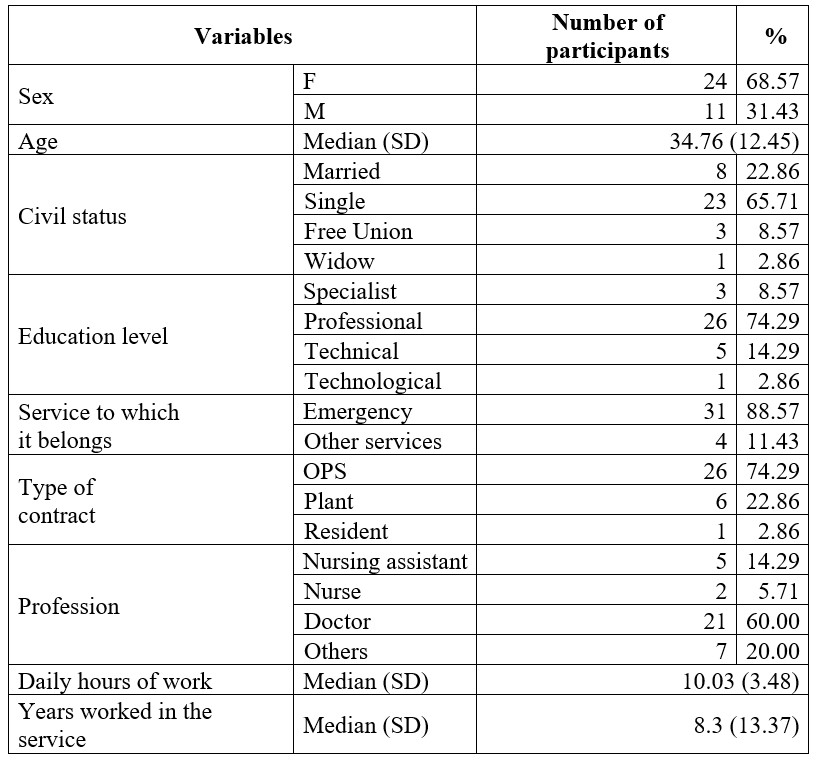
Regarding the participants' perception of emotional discomfort, the data analysis revealed a difference before and after the intervention. Before the intervention, only 11% of the participants reported having no emotional discomfort, whereas after the intervention, 63% reported having no emotional discomfort. Figure 1 illustrates the comparison of the level of discomfort perception before and after the intervention. The statistical analysis revealed statistically significant differences (p = 0.001) between the measurements before (median, IQR) and after (median, IQR) the intervention, demonstrating a decrease in the level of stress expressed by the participants after the intervention, taking them to the room.
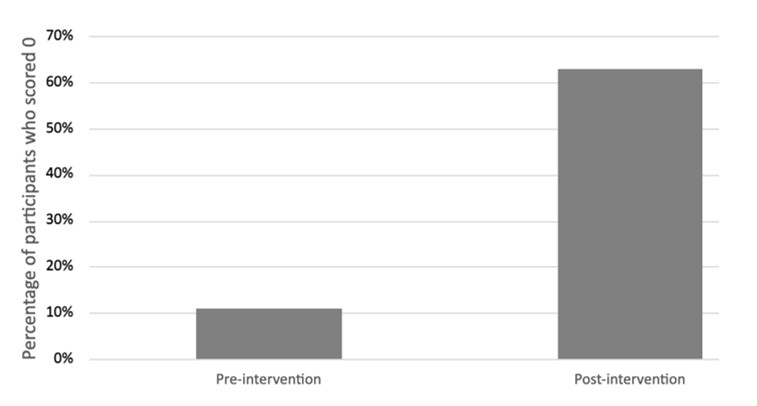 Figure 1.
Comparison of the level of discomfort perception before and after the intervention
Figure 1.
Comparison of the level of discomfort perception before and after the intervention
In the qualitative analysis, participants frequently reported feelings of anxiety, sadness, lack of energy, boredom, body pain, drowsiness, hunger, and nostalgia in the pre-intervention interviews. However, some participants reported feeling curious, active, focused, calm, and safe. In the post-intervention interviews, there were frequent expressions of relaxation, decreased anxiety, satisfaction, reactivation of energy, decreased stress, comfort, peace, encouragement, positive attitude, renewal, enjoyment, freshness, and fun. Strikingly, some participants expressed that "it was an escape space," "I wanted to stay a while longer", "it gave me ideas to relax at home", and "in the room, I forgot everything". However, two participants reported feeling discomfort - one reported a headache, and the other reported dizziness.
In analyzing the maps of personal meaning, only the information that participants recorded on the sheets of paper was taken into account, and a score was assigned depending on the type of language used (24): complete sentences were given 3 points, incomplete sentences were given 2 points, and isolated words were given 1 point. The results show an increase in the content of complete sentences in the maps of personal meaning, as well as a decrease in incomplete and isolated sentences. The summarized results are presented in Table 2.
Table 2.
Analysis of the content of the personal meaning maps after the intervention

Below is an example of a personal meaning map made by a participant (Figure 2). The black color refers to the concepts used by the participant before the intervention, and the green color to those concepts written by the same participant after the intervention.
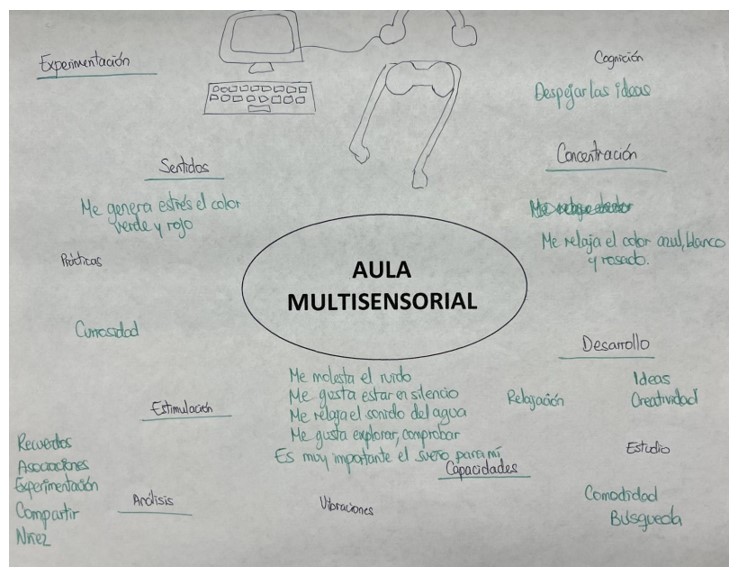 Figure 2.
Personal meaning map developed by a participant
Figure 2.
Personal meaning map developed by a participant
To compare the number of relevant concepts used by participants in their personal meaning maps before and after experiencing the multisensory room, a grammatical analysis was performed, identifying content words, which give meaning to sentences. This category includes nouns, adjectives, and verbs, while connectors were not analyzed. Table 3 summarizes the results.
Table 3.
Number of relevant concepts used by participants in their personal meaning maps before and after the intervention

The data shows a decrease in the overall number of words, particularly adjectives and verbs. Furthermore, the type of nouns used changed, indicating a shift in the concepts acquired by the participants regarding the multisensory room after the intervention. To provide a clearer visualization of this shift, we utilized the free software WordArt to create an image displaying the most frequently used words both before and after the intervention (Figure 3).
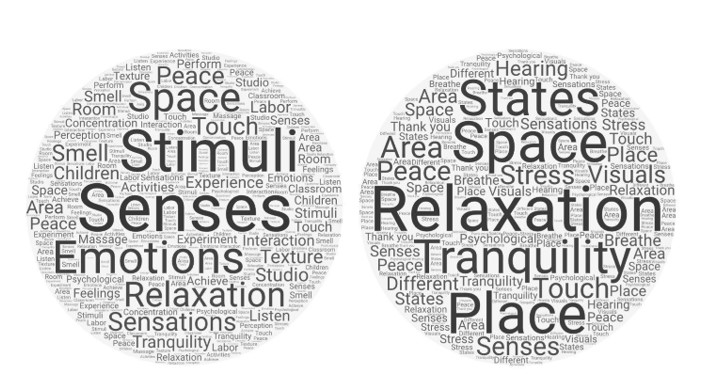 Figure 3.
A) Word cloud prior to interaction in the multisensory room. B) Post-interaction word cloud in the multi-sensory room
Figure 3.
A) Word cloud prior to interaction in the multisensory room. B) Post-interaction word cloud in the multi-sensory room
There was a notable shift in the most frequently used words by the participants. Prior to the intervention, the most commonly used words were "stimuli," "senses," and "emotions," whereas after the intervention, they were "relaxation," "space," and "tranquility."
Discussion
The present study was a pilot trial conducted in a hospital environment during the pandemic, which presented a significant challenge to its implementation. Nevertheless, the study was motivated by the pressing need for mental health support for healthcare personnel dealing with the pandemic and the importance of generating scientific evidence in this field. The study was both timely and relevant, given the urgency of interventions of this kind during a pandemic. The intervention was offered at a critical moment to help mitigate the mental health effects of the pandemic on healthcare workers. The research team's innovative use of an existing resource, the Snoezelen room, which had been closed due to the pandemic, highlights their resourcefulness in meeting the important, urgent, and often invisible needs of healthcare worker.
In terms of the potential effects of the intervention, a statistically significant change was observed in the measurement of the perception of discomfort between the pre- and post-tests of the study. This change was attributed to a reduction in the post-test mean by over one point, indicating that multiple sensory stimulation is effective in reducing discomfort.
Additionally, qualitative exploration revealed that participants often attributed this positive change to the intervention, as some reported transitioning from feelings of sadness, anxiety, and pain to relaxation, reactivation, and peace. These findings are consistent with those of other studies, such as Momeni et al. (19), who documented a decrease in postpartum anxiety after an intervention in the Snoezelen room, and Collier et al. (21), who found that the use of the Snoezelen room was helpful in reducing anxiety and stress levels in nursing staff. While the findings of this study are limited by the empirical indicator used, it can be concluded that emotional regulation of sadness, anxiety, and nostalgia could potentially be effects of the intervention. Future studies should test the efficacy of interventions of this type with more robust designs, including control groups, probabilistic sampling, random assignment, and the use of indicators with appropriate psychometric properties for the population and study context.
Regarding the limitations of this study, it should be noted that it was an exploratory study that utilized convenience sampling and measured its effects with a single empirical indicator. Thus, caution should be exercised when attributing the observed effects to the intervention and when generalizing the results. Nevertheless, the study made a significant contribution by demonstrating the feasibility of conducting research in a real-world setting and by showcasing the ingenuity of repurposing existing resources to address emerging problems. Future studies that are conducted under more controlled conditions may provide more insights into the potential of interventions with the Snoezelen room for improving the mental health of healthcare personnel who work in hospitals.
References
1. Johns Hopkins Coronavirus Resource Center. Home [Internet]. [Cited 2021 Oct 22]. Available from: https://coronavirus.jhu.edu/
2. Daniels JP. COVID-19 cases arise in Colombia. Lancet (London, England) [Internet] 2020;396(10246):227. https://doi.org/10.1016/S0140-6736(20)31638-X
3. Idrovo A. More social discontent than pandemic-related risk perception in Colombia. Lancet. 2021;398(10296):211. https://doi.org/10.1016/S0140-6736(21)01239-3
4. Fernández-Niño JA, Peña C. Potential effects of social protests in Colombia on the transmission of COVID-19. SSRN Electron J. 2021. https://doi.org/10.2139/ssrn.3899602
5. Shultz JM, Berg RC, Acevedo OAB, Cañas JAO, Escobar VAP, Muñoz O, et al. Complex correlates of Colombia's COVID-19 emerges. Lancet Reg Heal – Am. 2021;3:100072. https://doi.org/10.1016/j.lana.2021.100072
6. Martín-Delgado J, Viteri E, Mula A, Serpa P, Pacheco G, Prada D, et al. Availability of personal protective equipment and diagnostic and treatment facilities for healthcare workers involved in COVID-19 care: a cross-sectional study in Brazil, Colombia, and Ecuador. PLoS One. 2020;15(11):e0242185. https://doi.org/10.1371/journal.pone.0242185
7. Taylor L. Covid-19 misinformation sparks threats and violence against doctors in Latin America. BMJ. 2020; 370. https://doi.org/10.1136/bmj.m3088
8. Turner S, Niño N, Segura C, Botero-Tovar N. Organizational responses to mitigate the effects of COVID-19 on healthcare workers: a qualitative case study from Bogotá, Colombia. BMC Heal Serv Res 2021 211. 2021;21(1):1–10. https://doi.org/10.1186/s12913-021-06825-2
9. Alnazly E, Khraisat OM, Al-Bashaireh AM, Bryant CL. Anxiety, depression, stress, fear and social support during COVID-19 pandemic among Jordanian healthcare workers. PLoS One. 2021;16(3):e0247679. https://doi.org/10.1371/journal.pone.0247679
10. Mohsin SF, Agwan MA, Shaikh S, Alsouwaydani ZA, AlSuwaydani SA. COVID-19: fear and anxiety among healthcare workers in Saudi Arabia. A cross-sectional study. Inquiry. 2021 Jan-Dec;58:469580211025225. https://doi.org/10.1177/00469580211025225
11. Aly HM, Nemr NA, Kishk RM, Elsaid NMA bakr. Stress, anxiety and depression among healthcare workers facing COVID-19 pandemic in Egypt: a cross-sectional online-based study. BMJ Open. 2021;11(4):e045281. https://doi.org/10.1136/bmjopen-2020-045281
12. Villarreal-Zegarra D, Copez-Lonzoy A, Vilela-Estrada AL, Huarcaya-Victoria J. Depression, post-traumatic stress, anxiety, and fear of COVID-19 in the general population and health-care workers: prevalence, relationship, and explanatory model in Peru. BMC Psychiatry. 2021; (1):1–14. https://doi.org/10.1186/s12888-021-03456-z
13. Monterrosa-Castro A, Dávila-Ruiz R, Mejía-Mantilla A, Contreras-Saldarriaga J, Mercado-Lara M, Florez-Monterrosa C. Work stress, anxiety, and fear of COVID-19 in Colombian general practitioners. MedUNAB 2020; 23(2):195–213. https://doi.org/10.29375/01237047.3890
14. Monterrosa-Castro Á, Buelvas-de-la-Rosa C, Ordosgoitia-Parra E. Probable generalized anxiety disorder in the COVID-19 pandemic: assessment in general practitioners in the Colombian Caribbean. Duazary [Internet]. 2021 [cited 2021 Oct 22];18(1):7–19. Available from: https://revistas.unimagdalena.edu.co/index.php/duazary/article/view/3890
15. Priede A, López-Álvarez I, Carracedo-Sanchidrián D, González-Blanch C. Mental health interventions for healthcare workers during the first wave of COVID-19 pandemic in Spain. Rev Psiquiatr Salud Ment (Engl Ed). 2021;14(2):83–9. https://doi.org/10.1016/j.rpsm.2021.01.005
16. Tomlin J, Dalgleish-Warburton B, Lamph G. Psychosocial support for healthcare workers during the COVID-19 pandemic. Front Psychol 2020;11:1960. doi: https://doi.org/10.3389/fpsyg.2020.01960
17. Toro B. Memory and standing balance after multisensory stimulation in a Snoezelen room in people with moderate learning disabilities. Br J Learn Disabled. 2019;47(4):270–8. https://doi.org/10.1111/bld.12289
18. Novakovic N, Milovancevic MP, Dejanovic SD, Aleksic B. Effects of Snoezelen—Multisensory environment on CARS scale in adolescents and adults with autism spectrum disorder. Res Dev Disabil 2019; 89:51–8. https://doi.org/10.1016/j.ridd.2019.03.007
19. Momeni M, Jamshidimanesh M, Ranjbar H. Effectiveness of a Snoezelen room on fear, anxiety, and satisfaction of nulliparous women: a randomized controlled trial. Iran J Psychiatry Behav Sci. 2020;14(2). https://doi.org/10.5812/ijpbs.89168
20. Berkheimer SD, Qian C, Malmstrom TK. Snoezelen therapy as an intervention to reduce agitation in nursing home patients with dementia: a pilot study. J Am Med Dir Assoc. 2017;18(12):1089–91. https://doi.org/10.1016/j.jamda.2017.09.009
21. Collier L, Staal J, Homel P. Multisensory environmental therapy (Snoezelen) for job stress reduction in mental health nurses: a randomized trial. Int J Complement Alt Med. 2018;11(1):49-54. https://doi.org/10.15406/ijcam.2018.11.00346
22. Falk JH. Personal meaning mapping. In: Caban G, ScottC, Falk JH, Dierking LD, editors. Museums and creativity: a study into the role of museums in design education. Sydney: Powerhouse Publishing; 2003. p. 10-18.
23. Buitrago Bedoya JP, Rúa Gallego EM. El acuario del Parque Explora como un lugar para el fomento del cuidado y la conservación del medio ambiente en sus visitantes [Internet]. Universidad de Antioquia; 2016 [cited 2023 Mar 7]. Available from: https://bibliotecadigital.udea.edu.co/bitstream/10495/26188/1/BuitragoJuan_2013_AcuarioAmbienteVisitantes.pdf
Author notes
a Correspondence author: arbepaulaag@gmail.com
Additional information
How to cite: Lozano-Mosos J-S, Colina-Matiz S, Carreño-Moreno S, Arbeláez-Gutiérrez P, Salinas L. Multisensory stimulation and its effect on health personnel working in covid areas: a pilot trial. Salud Javeriana. 2024;1. https://doi.org/10.11144/Javeriana.salud1.mseh















